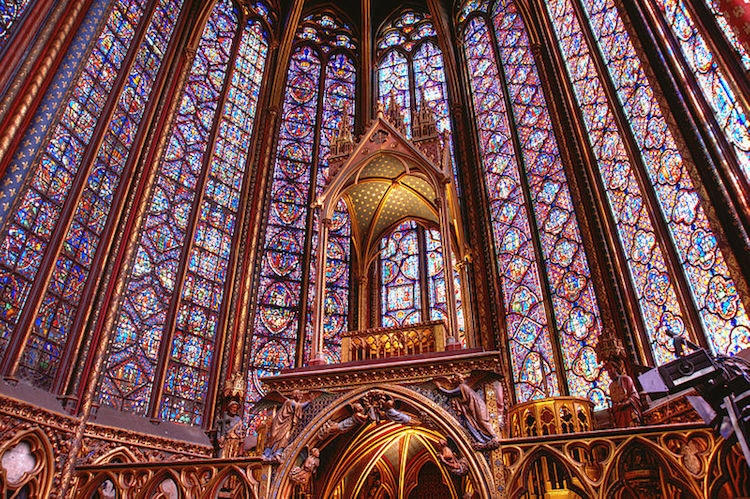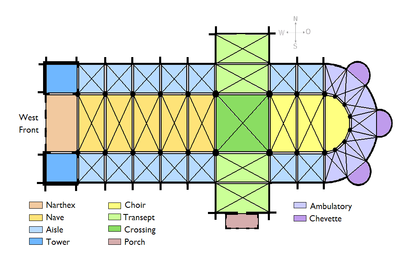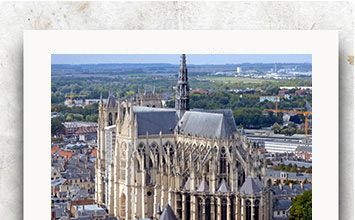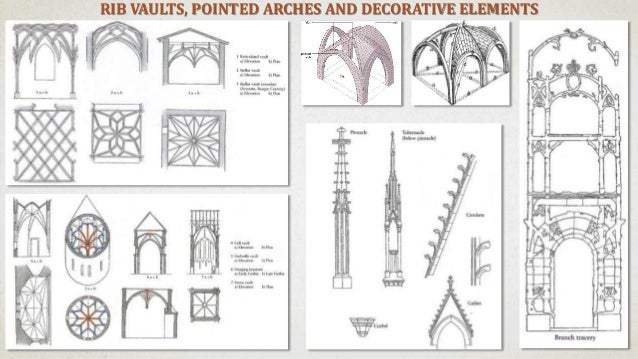Your Gothic architecture explained images are available. Gothic architecture explained are a topic that is being searched for and liked by netizens today. You can Download the Gothic architecture explained files here. Download all free photos and vectors.
If you’re looking for gothic architecture explained pictures information connected with to the gothic architecture explained topic, you have come to the right site. Our site always gives you hints for seeing the maximum quality video and image content, please kindly hunt and locate more enlightening video content and graphics that fit your interests.
Gothic Architecture Explained. It spread to all Southern and Central Europe without affecting other classical styles in Italy. The action takes place. Originating in 12th-century France and. The Gothic was an early art movement which changed the shape of Europe formalising old traditions and paving the way for progress.
 Gothic Architecture Characteristics That Define The Gothic Style From mymodernmet.com
Gothic Architecture Characteristics That Define The Gothic Style From mymodernmet.com
Gothic architecture is a way of planning and designing buildings that developed in Western Europe in the Late Middle Ages. The Gothic was an early art movement which changed the shape of Europe formalising old traditions and paving the way for progress. The pointed arch the ribbed vault and the flying buttress the defining elements of Gothic architecture all originated from preceding Romanesque buildings but never found employment together in a single building. The principal structural characteristics of Gothic architecture arose out of medieval masons efforts to solve the problems associated with supporting heavy masonry ceiling vaults over wide spans. Learn more about the features and basic ideas that go. Gothic architecture architectural style in Europe that lasted from the mid-12th century to the 16th century particularly a style of masonry building characterized by cavernous spaces with the expanse of walls broken up by overlaid tracery.
The Gothic was an early art movement which changed the shape of Europe formalising old traditions and paving the way for progress.
Gothic architecture was the precursor to Gothic art setting the foundations for a movement which would span some 400 years. A little something to help you recognize and understand gothic architectureEasy Architecture is a continuing web series that explains architecture to people. The Movement Explained in 8 Works Flying buttresses and humanist sculptures the Gothic movement is responsible for some of Europes best-loved art and architecture. Gothic Art and Architecture. Though its roots are French the Gothic approach can be found in churches cathedrals and other similar buildings in Europe and beyond. It evolved from Romanesque architecture and was succeeded by Renaissance architecture.
 Source: hisour.com
Source: hisour.com
It also supports much more weight than previously used pillars. Gothic architecture is a European style of architecture that values height and exhibits an intricate and delicate aesthetic. The Movement Explained in 8 Works Flying buttresses and humanist sculptures the Gothic movement is responsible for some of Europes best-loved art and architecture. The pointed arch the ribbed vault and the flying buttress the defining elements of Gothic architecture all originated from preceding Romanesque buildings but never found employment together in a single building. Learn more about the features and basic ideas that go.
 Source: pinterest.com
Source: pinterest.com
It spread to all Southern and Central Europe without affecting other classical styles in Italy. Gothic architecture architectural style in Europe that lasted from the mid-12th century to the 16th century particularly a style of masonry building characterized by cavernous spaces with the expanse of walls broken up by overlaid tracery. It also supports much more weight than previously used pillars. Such naming is followed up in many cases by setting them in Gothic buildings. Originating in 12th-century France and.
 Source: mymodernmet.com
Source: mymodernmet.com
The Gothic architecture style found in churches synagogues and cathedrals built between approximately 1100 to 1450 CE stirred the imagination of painters poets and religious thinkers in Europe and Great Britain. The principal structural characteristics of Gothic architecture arose out of medieval masons efforts to solve the problems associated with supporting heavy masonry ceiling vaults over wide spans. Gothic Architecture is a style of architecture that flourished during the high and late Medieval Period. Gothic architecture is a style of architecture that flourished during the high and late medieval period. The pointed arches were a.
 Source: wikiwand.com
Source: wikiwand.com
Originating in 12th-century France and. Gothic architecture - a style of architecture developed in northern France that spread throughout Europe between the 12th and 16th centuries. Buildings designed in the Gothic style are characterised by their lofty vaults flying buttresses. Like many other characteristics of Gothic architecture the use of pointed arch is both practical and decorative. A little something to help you recognize and understand gothic architectureEasy Architecture is a continuing web series that explains architecture to people.
 Source: medium.com
Source: medium.com
Gothic Art and Architecture. Ornate intricate and heavy-handed this style of architecture proved to be the. Gothic architecture grew out of Romanesque architecture in. It distributes the force of heavier ceilings and bulky wall. Originating in 12th century France and lasting into the 16th century Gothic architecture was known during the period as amp.
 Source: study.com
Source: study.com
Originating in 12th-century France and. The action takes place. Gothic architecture is a way of planning and designing buildings that developed in Western Europe in the Late Middle Ages. Originating in 12th century France and lasting into the 16th century Gothic architecture was known during the period as amp. It distributes the force of heavier ceilings and bulky wall.
 Source: slideshare.net
Source: slideshare.net
Gothic architecture is a European style of architecture that values height and exhibits an intricate and delicate aesthetic. The principal structural characteristics of Gothic architecture arose out of medieval masons efforts to solve the problems associated with supporting heavy masonry ceiling vaults over wide spans. Gothic Architecture is a style of architecture that flourished during the high and late Medieval Period. Buildings designed in the Gothic style are characterised by their lofty vaults flying buttresses. Gothic architecture is a way of planning and designing buildings that developed in Western Europe in the Late Middle Ages.
 Source: mymodernmet.com
Source: mymodernmet.com
Architecture itself plays a role in naming Gothic novels with many titles referring to castles or other common Gothic buildings. Gothic architecture is a European style of masonry that values height intricacy sizable windows and exaggerated arches. The Movement Explained in 8 Works Flying buttresses and humanist sculptures the Gothic movement is responsible for some of Europes best-loved art and architecture. Like many other characteristics of Gothic architecture the use of pointed arch is both practical and decorative. The principal structural characteristics of Gothic architecture arose out of medieval masons efforts to solve the problems associated with supporting heavy masonry ceiling vaults over wide spans.
 Source: visual-arts-cork.com
Source: visual-arts-cork.com
The action takes place. The pointed arches were a. Gothic architecture is a style of architecture that flourished during the high and late medieval period. Such naming is followed up in many cases by setting them in Gothic buildings. The pointed arch the ribbed vault and the flying buttress the defining elements of Gothic architecture all originated from preceding Romanesque buildings but never found employment together in a single building.

The word gothic evokes images of the massive ornately decorated cathedrals built in medieval Europe. Though its roots are French the Gothic approach can be found in churches cathedrals and other similar buildings in Europe and beyond. Gothic Art and Architecture. Gothic architecture is a European style of architecture that values height and exhibits an intricate and delicate aesthetic. Originating in 12th century France and lasting into the 16th century Gothic architecture was known during the period as amp.
 Source: slideshare.net
Source: slideshare.net
A little something to help you recognize and understand gothic architectureEasy Architecture is a continuing web series that explains architecture to people. Gothic architecture grew out of Romanesque architecture in. Gothic architecture is a European style of masonry that values height intricacy sizable windows and exaggerated arches. Gothic architecture is a European style of architecture that values height and exhibits an intricate and delicate aesthetic. Gothic architecture architectural style in Europe that lasted from the mid-12th century to the 16th century particularly a style of masonry building characterized by cavernous spaces with the expanse of walls broken up by overlaid tracery.
 Source: pinterest.com
Source: pinterest.com
Buildings designed in the Gothic style are characterised by their lofty vaults flying buttresses. Gothic art architecture and sculpture are the characteristics of the two great eras that developed in Central and Western Europe during the Middle Ages. Architecture was the most important and original art form during the Gothic period. Though its roots are French the Gothic approach can be found in churches cathedrals and other similar buildings in Europe and beyond. Learn more about the features and basic ideas that go.

Such naming is followed up in many cases by setting them in Gothic buildings. Gothic Art and Architecture. The term Gothic originates with the architecture created by the Germanic Goth tribes that was later expanded to include most medieval architecture. The Gothic was an early art movement which changed the shape of Europe formalising old traditions and paving the way for progress. Such naming is followed up in many cases by setting them in Gothic buildings.
 Source: theartstory.org
Source: theartstory.org
Gothic architecture grew out of Romanesque architecture in. Such naming is followed up in many cases by setting them in Gothic buildings. Like many other characteristics of Gothic architecture the use of pointed arch is both practical and decorative. Gothic architecture grew out of Romanesque architecture in. The Gothic was an early art movement which changed the shape of Europe formalising old traditions and paving the way for progress.
 Source: britannica.com
Source: britannica.com
Buildings designed in the Gothic style are characterised by their lofty vaults flying buttresses. Architecture was the most important and original art form during the Gothic period. Gothic architecture is a European style of architecture that values height and exhibits an intricate and delicate aesthetic. Gothic architecture architectural style in Europe that lasted from the mid-12th century to the 16th century particularly a style of masonry building characterized by cavernous spaces with the expanse of walls broken up by overlaid tracery. It spread to all Southern and Central Europe without affecting other classical styles in Italy.
 Source: wikiwand.com
Source: wikiwand.com
Learn more about the features and basic ideas that go. Gothic architecture was the precursor to Gothic art setting the foundations for a movement which would span some 400 years. The action takes place. Gothic architecture is a style of architecture that flourished during the high and late medieval period. The Movement Explained in 8 Works Flying buttresses and humanist sculptures the Gothic movement is responsible for some of Europes best-loved art and architecture.
 Source: slideshare.net
Source: slideshare.net
Gothic architecture is a European style of architecture that values height and exhibits an intricate and delicate aesthetic. Buildings designed in the Gothic style are characterised by their lofty vaults flying buttresses. Learn more about the features and basic ideas that go. It also supports much more weight than previously used pillars. In the 12th century advancements in engineering allowed for increasingly colossal buildings and the style.
 Source: theartstory.org
Source: theartstory.org
Architecture was the most important and original art form during the Gothic period. It distributes the force of heavier ceilings and bulky wall. Gothic art architecture and sculpture are the characteristics of the two great eras that developed in Central and Western Europe during the Middle Ages. Gothic architecture architectural style in Europe that lasted from the mid-12th century to the 16th century particularly a style of masonry building characterized by cavernous spaces with the expanse of walls broken up by overlaid tracery. The Gothic was an early art movement which changed the shape of Europe formalising old traditions and paving the way for progress.
This site is an open community for users to do submittion their favorite wallpapers on the internet, all images or pictures in this website are for personal wallpaper use only, it is stricly prohibited to use this wallpaper for commercial purposes, if you are the author and find this image is shared without your permission, please kindly raise a DMCA report to Us.
If you find this site value, please support us by sharing this posts to your preference social media accounts like Facebook, Instagram and so on or you can also save this blog page with the title gothic architecture explained by using Ctrl + D for devices a laptop with a Windows operating system or Command + D for laptops with an Apple operating system. If you use a smartphone, you can also use the drawer menu of the browser you are using. Whether it’s a Windows, Mac, iOS or Android operating system, you will still be able to bookmark this website.






